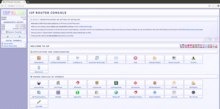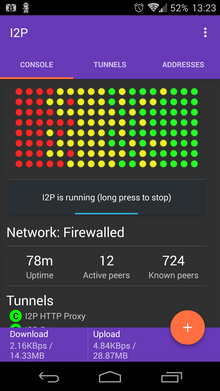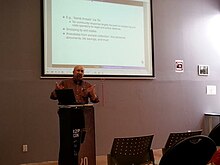| Version
|
Release date
|
Release Notes
|
| Old version, no longer maintained: 0.9.11
|
2014-02-08
|
Support for outproxy plugins, improves lease set lookup security, and reduces memory usage.[14]
|
| Old version, no longer maintained: 0.9.12
|
2014-03-31
|
Support for ECDSA and updates to Jetty 8.[15]
|
| Old version, no longer maintained: 0.9.13
|
2014-05-22
|
SusiMail improvements and fixes for firewalled router.[16]
|
| Old version, no longer maintained: 0.9.14
|
2014-07-26
|
Critical fixes for XSS and remote execution vulnerabilities.[17]
|
| Old version, no longer maintained: 0.9.14.1
|
2014-08-09
|
I2PSnark and console fixes.[18]
|
| Old version, no longer maintained: 0.9.15
|
2014-09-20
|
Preliminary support for Ed25519 EdDSA signatures.[19]
|
| Old version, no longer maintained: 0.9.16
|
2014-11-01
|
Add support for stronger Router Info signatures.[20]
|
| Old version, no longer maintained: 0.9.17
|
2014-11-30
|
Signed news, ECDSA tunnels by default.[21]
|
| Old version, no longer maintained: 0.9.18
|
2015-02-22
|
Shortened the startup time, and reduced latency throughout our network protocols.[22]
|
| Old version, no longer maintained: 0.9.19
|
2015-04-12
|
Several fixes and improvements for floodfill performance.[23]
|
| Old version, no longer maintained: 0.9.20
|
2015-06-02
|
Important bug fixes, and several changes to increase floodfill capacity in the network.[24]
|
| Old version, no longer maintained: 0.9.21
|
2015-07-31
|
Contains several changes to add capacity to the network, increase the efficiency of the floodfills, and use bandwidth more effectively.[25]
|
| Old version, no longer maintained: 0.9.22
|
2015-09-12
|
Fixes for I2PSnark getting stuck before completion, and begins the migration of router infos to new, stronger Ed25519 signatures.[26]
|
| Old version, no longer maintained: 0.9.23
|
2015-11-19
|
Accelerates the rekeying process.[27]
|
| Old version, no longer maintained: 0.9.24
|
2016-01-27
|
A new version of SAM (v3.2) and numerous bug fixes and efficiency improvements. The first release to require Java 7.[28]
|
| Old version, no longer maintained: 0.9.25
|
2016-03-22
|
A new version of SAM (v3.3), QR codes for sharing hidden services, identicons and router families.[29]
|
| Old version, no longer maintained: 0.9.26
|
2016-06-07
|
Major upgrade to the native crypto library, a new addressbook subscription protocol with signatures, and major improvements to the Debian/Ubuntu packaging.[30]
|
| Old version, no longer maintained: 0.9.27
|
2016-10-17
|
Improvements in IPv6 transports, SSU peer testing, and hidden mode.[31]
|
| Old version, no longer maintained: 0.9.28
|
2016-12-12
|
Updates for a number of bundled software, fixes for IPv6 peer testing, improvements to detect and block potentially malicious peers. Preliminary fixes for Java 9.[32]
|
| Old version, no longer maintained: 0.9.29
|
2017-02-27
|
Support for NTP over IPv6, preliminary Docker support, translated main pages. We now pass same-origin Referrer headers through the HTTP proxy. There are more fixes for Java 9, although we do not yet recommend Java 9 for general use.[33]
|
| Old version, no longer maintained: 0.9.30
|
2017-05-03
|
Support for Debian Stretch and Ubuntu Zesty, upgraded to Jetty 9 and Tomcat 8, support for the migration of old DSA-SHA1 hidden services to the EdDSA signature type.[34]
|
| Old version, no longer maintained: 0.9.31
|
2017-08-07
|
Refreshed the router console to improve readability, improved accessibility and cross-browser support, and general tidying up.[35]
|
| Old version, no longer maintained: 0.9.32
|
2017-11-07
|
0.9.32 contains a number of fixes in the router console and associated webapps (addressbook, i2psnark, and susimail). We have also changed the way we handle configured hostnames for published router infos, to eliminate some network enumeration attacks via DNS. Added some checks in the console to resist rebinding attacks.[36]
|
| Old version, no longer maintained: 0.9.33
|
2018-01-30
|
0.9.33 contains bug fixes for i2psnark, i2ptunnel, streaming, and SusiMail. Updates for reseed proxying, and default rate limiting.[37]
|
| Old version, no longer maintained: 0.9.34
|
2018-04-10
|
0.9.34 contains bug fixes for i2ptunnel, router console, SusiMail, routing and transport along with Changes to SusiMail and UPnP.[38]
|
| Old version, no longer maintained: 0.9.35
|
2018-06-26
|
0.9.35 adds support for folders in SusiMail, and a new SSL Wizard for setting up HTTPS on your Hidden Service website.[39]
|
| Old version, no longer maintained: 0.9.36
|
2018-08-23
|
0.9.36 implements a new, more secure transport protocol called NTCP2. It is disabled by default, but you may enable it for testing. NTCP2 will be enabled in the next release.[40]
|
| Old version, no longer maintained: 0.9.37
|
2018-10-04
|
0.9.37 enables the faster, more secure transport protocol called NTCP2.[41]
|
| Old version, no longer maintained: 0.9.38
|
2019-01-22
|
0.9.38 includes a new first-install wizard with a bandwidth tester. We've added support for the latest GeoIP database format. There's a new Firefox profile installer and a new, native Mac OSX installer on our website. Work continues on supporting the new "LS2" netdb format.[42]
|
| Old version, no longer maintained: 0.9.39
|
2019-03-21
|
0.9.39 includes extensive changes for the new network database types (proposal 123). We've bundled the i2pcontrol plugin as a webapp to support development of RPC applications. There are numerous performance improvements and bug fixes.[43]
|
| Old version, no longer maintained: 0.9.40
|
2019-05-07
|
0.9.40 includes support for the new encrypted leaseset format. We disabled the old NTCP 1 transport protocol. There's a new SusiDNS import feature, and a new scripted filtering mechanism for incoming connections.[44]
|
| Old version, no longer maintained: 0.9.41
|
2019-07-02
|
0.9.41 continues the work to implement new features for proposal 123, including per-client authentication for encrypted leasesets. The console has an updated I2P logo and several new icons. We've updated the Linux installer.[45]
|
| Old version, no longer maintained: 0.9.42
|
2019-08-28
|
0.9.42 continues the work to make I2P faster and more reliable. It includes several changes to speed up our UDP transport. We have split up the configuration files to enable future work for more modular packaging. We continue work to implement new proposals for faster and more secure encryption. There are, of course, a lot of bug fixes also.[46]
|
| Old version, no longer maintained: 0.9.43
|
2019-10-22
|
0.9.43 release continues work on stronger security and privacy features and performance improvements. Our implementation of the new leaseset specification (LS2) is now complete. We are beginning our implementation of stronger and faster end-to-end encryption (proposal 144) for a future release. Several IPv6 address detection issues have been fixed, and there of course are several other bug fixes.[47]
|
| Old version, no longer maintained: 0.9.44
|
2019-12-01
|
0.9.44 contains an important fix for a denial of service issue in hidden services handling of new encryption types.[48]
|
| Old version, no longer maintained: 0.9.45
|
2020-02-25
|
0.9.45 contains bug fixes.[49]
|
| Old version, no longer maintained: 0.9.46
|
2020-05-25
|
0.9.46 contains new ECIES Encryption.[50]
|
| Old version, no longer maintained: 0.9.47
|
2020-08-24
|
0.9.47 enables new encryption for some services, now requires Java 8 and Sybil analysis and blocking is now enabled by default.[51]
|
| Old version, no longer maintained: 0.9.48
|
2020-11-30
|
0.9.48 enables new encryption for most services, has significant performance improvements.[52]
|
| Old version, no longer maintained: 0.9.49
|
2021-02-17
|
0.9.49 improves SSU transport and begins transition to X25519 encryption for routers.[53]
|
| Old version, no longer maintained: 0.9.50
|
2021-05-17
|
0.9.50 continues transition to X25519 encryption for routers, enables DoH for reseeding and improves support for IPv6.[54]
|
| Old version, no longer maintained: 1.5.0
|
2021-08-23
|
1.5.0 adds short tunnel build messages, continues transition to X25519 encryption for routers and improves performance.[55]
|
| Current stable version: 1.6.1[56]
|
2021-11-29
|
1.6.1 further accelerates transition to X25519 for routers, enables short tunnel build messages and improves SSU performance.[57]
|
|







